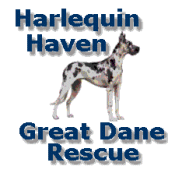|
Bloat
& Torsion
Bloat and Torsion are the biggest killers
of large breed dogs, and yet they are the most unknown by even many
veterinarians.
Canine Bloat (Gastric Dilation-Volvulus
or GDV)
is an acute disease or digestive problem believed to be caused by
excessive swallowing of air while eating; gastrointestinal secretions;
and gas from food fermenting in the stomach.
Bloat and Torsion are life threatening
emergencies. Some symptoms may be: anxiety, evidence of abdominal
fullness after meals, heavy salivating, whining, pacing, getting up and
lying down, stretching, looking at the abdomen, unproductive attempts to
vomit, labored breathing, disinterest in food, and stilted gait. Severe
symptoms, such as dark red, gray, or white gums, a rapid heartbeat, and a
weak pulse are normally followed by prostration and death.
Learn the natural color of your dog's
gums and their recovery rate from compression. To do this, press on the
gums firmly with your finger and then let go. The color should return
immediately. If the color returns slowly or not at all, you have an
emergency and must seek veterinary help ASAP.
PHASE 1 SYMPTOMS: Pacing, restlessness,
panting and salivating. There may be unproductive attempts to vomit
(every 10-20 minutes), and the abdomen appears full and/or enlarging.
PHASE 2 SYMPTOMS: Very restless, whining,
pacing continuously, heavy salivating, unproductive attempts to vomit
(every 2-3 minutes), dark red gums, high heart rate (80-100 bpm),
abdomen is enlarged and tight and emits a hollow should when thumped.
PHASE 3 SYMPTOMS: Gums are white or blue,
dog is unable to stand or has legs spread, shaky stance, abdomen is very
enlarged, heart rate is extremely high (100 bpm or higher) and pulse is
weak.
As you can tell, each phase is getting
worse. However, remember that no matter which phase your dog is in, the
best and only way to save your beloved pet is to rush him or her to the
nearest competent veterinarian. It's always better to have a false alarm
than a dead Dane.
Remember also that you know your dog
better than any veterinarian. If the vet is unsure, have an x-ray taken.
If the x-ray shows you are right, surgery should follow immediately.
There is no time to waste, and the sooner the operation, the better the
survival rate.
Veterinarians continue to study the bloat
problem and still have many questions which need answers. Below is a
list of suggestions to help prevent bloat.
1) Feed 2 or 3 times daily, rather than
once, and always when someone can watch the dog after he/she has eaten.
2) Avoid exercise, excitement and stress
for 1 hour before and 2 hours after eating.
3) Feed dogs individually and in a quiet
location.
4) Make diet changes gradually over a 3
to 5 day period.
5) Make sure water is available, but
limited, after eating and exercise.
6) Watch for any actions or behavior that
may signal abdominal discomfort.
7) Establish a good relationship with a
veterinarian, discussing emergency procedures. Always have a back up
veterinarian.
8) When in doubt, give us a call. We have
been wrong only a couple of times. One dog died. The owner felt we were
wrong and didn't go to the vet until the next day and then it was too
late.
All images and text on this site Copyright © 1998-2025 Harlequin Haven Great Dane Rescue, Inc. unless otherwise credited. Use of any image or text without written permission is expressly forbidden. All rights reserved.
|
